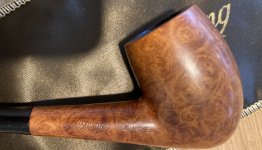I am very particular when it comes to the shapes I collect. I probably have more billiards than any other shape followed by Dublins, Apples, Lovats, Brandy's, Rhodesians, one Volcano from Bruce Weaver that I love. I am a classic shape guy and rarely ever stray from them.
I believe that if a carver cannot make a seriously great shaped Billiard, then they should quit making other pipes until they can. For my tastes I won't give a carver a second look if I see an ugly Billiard they are trying to dump on the public. I see it all the time and I think the buyers for the companies need to be shown what a proper Billiard is and never sell the crappy ones. They should send them back to the carver with a note, try again and don't stop till you get it right. Here is just one example of what I call a proper Billiard. It is a 1966 Dunhill LB.

Here is a Jack Howell he recently made me.











